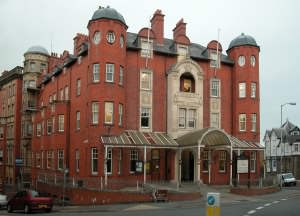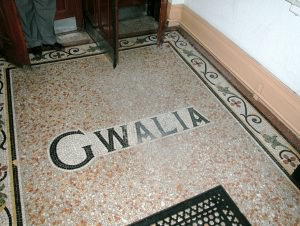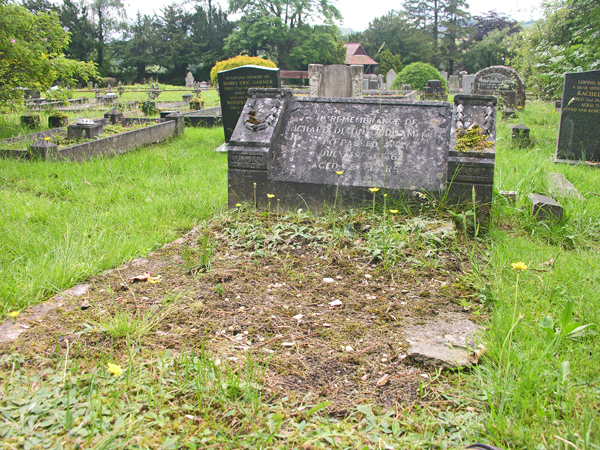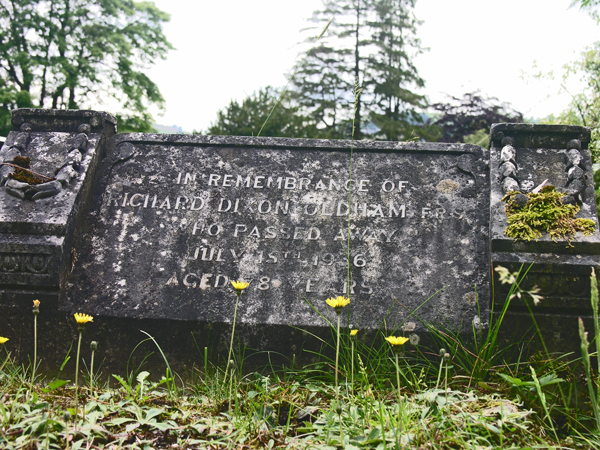R.D. Oldham Obituaries |
|
|
|
Obituaries and biographies Richard Oldham died 15 July 1936 at the age of 78 in the Wingfield Nursing Home in Llandrindod Wells. For several years he had resided at the Gwalia Hotel which is given as his address. The hotel is opposite to the entrance to the natural mineral-water spa in Landrindod Wells, but it is now an administrative center for Radnorshire. He was buried in the public cemetery. The alto-relief epitaph on his neglected granite headstone reads: IN REMEMBRANCE OF
RICHARD DIXON OLDHAM FRS
WHO PASSED AWAY
JULY 15 1936
AGED 78 YEARS
His estate was valued as £4559 18s 10d and it was awarded to the public trustee, possibly because local authorities were unaware of his surviving brother in Cambridge. Four obituaries were written by his contemporaries. In addition Davison wrote a brief biography, as did John Woodhouse largely from these sources. Lake, P., Obituary written by P.L Nature, 138, 316-317, 1936. Philip Lake, was a well-liked Professor of Geography in Cambridge who, during his three years in India, worked briefly with Oldham. Lake was ill for much of his time in India and requested to be released from his contract to return to the UK. Davison, C., Richard Dixon Oldham. 1858-1936, Obituary Notices of Fellows of the Royal Society, 2(5), (Dec., 1936), pp. 111-113 Davison, the seismologist, wrote several popular books on earthquakes, and one on "the Founders of Seismology", which contains numerous biographies on early seismologists. R.D. Oldham is mentioned incidently in this book. The book was based on a series of articles published under the same title in the Geological Magazine of London. He continued the series in the Geol. Mag., and Oldham's career is summarized in 2 pages in his fourth supplemental article. He was never to publish a second edition of the book. Davison was unfamiliar with Oldham's geological work and cited Oldham's publication count from a note by Holland written at the time of Oldham's retirement in 1902. Davison, C, (1937), Founders of Seismology, IV, Geol. Mag. 74(12), 532-534, Oldham, Richard, D., In this article Davison repeats his obituary materials briefly, and then recounts a few details of Oldham's seismological contributions. Middlemiss, C. S. Obituary Richard Dixon Oldham. 1858-1936, Q. J. Geol. Soc. 93, ciii-cv1, 1937. Middlemiss (1859-1945) was a colleague in the Geological Survey of India who, like Oldham, was never appointed a Director of the Survey, although officiated for a year in this capacity. Unlike Oldham, he stayed on past retirement and directed the search for minerals in Kashmir, ultimately becoming at aged 71 the longest surving geologist in India. His second article in India was on the Bengal earthquake of 1885, but his best known work is on the 1905 Kangra earthquake. His geological contributions to the study of the structure of the Himalaya were the first to recognise the parallel thrust system separating the Siwaliks from the Ganges sediments and the higher level thursts beneath the more highly metamorphosed Himalayan rocks. He also made important contributions to our understanding of the mobility of salt in the Salt range. As expected Middlemiss, in his obitury of Oldham focusses much on Oldham's contribution to Indian Geology. From his writing it is clear that Middlemiss maintained a friendship with Oldham after they both retired to England. Heron, A. M., Richard Dixon Oldham, Rec. Geol. Soc. India, 71(4), 347-9, 1937. Heron's obituary of Oldham was written while he was the director of the Survey of India in 1937 and had access to numerous materials. However, it contains much of the same information as Middlemiss, mentioning in addition his post-retirement activities in Burma, and in Hyeres in the south of France. Heron corresponded with Oldham concerning the texts of a copy of Alexander Burnes' map of the Rann of Kachchh in 1926. Both Heron and Middlemiss mention that Oldham suffered from the debilitating decease sprue - an intolerance of the intestine to gluten found in wheat, which can be inherited or, as tropical sprue, acquired, from drinking contaminated water especially in India. Antibiotics can nowadays cure sprue within 6 months. Woodhouse, J.H. (1993) Oldham, Richard Dixon. Dictionary of National Biography, Missing Persons. ed. Christine S. Nicholls, Oxford University Press, (1993). 502-503. John Woodhouse summarises information from the above sources and places Oldham's seismological discoveries in context.
|



